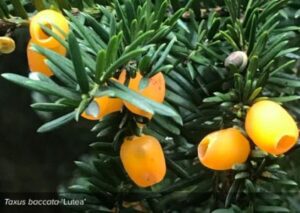The first Irish Heritage Plant (IHP) to be recorded is a variation of our native yew. The upright form with vertical branches which was found growing on a hillside close to Florencecourt, County Fermanagh, is known worldwide as the Irish yew.
It is not the only unique variation of the native yew, but its poisonous foliage and berries saw it mostly grown in churchyards and cemeteries, its tall columnar form like sentinels for those laid to rest. Yew is a dioecious species
meaning male and female flowers are produced on different plants. Taxus baccata ‘Lutea’ is, like the Irish yew, a female of the species and the fruits of this particular tree are yellow, distinct from the usual red fruits of most yew trees.
According to A Heritage of Beauty, yellow-fruited varieties were first documented as occurring in two places in Ireland, both on the north side of Dublin city, and have been in cultivation for more than two centuries.
A challenge for Society members is to find a place for what could eventually be a large tree. Yew has the advantage of responding well to clipping, and a topiary or hedged specimen may be easier to accommodate than a tree. Another
approach would be to find a local public space which has room for an IHP like the yellow-fruited yew so that we can continue to enjoy this colour variant of one of our native trees. On further thoughts, the local cemetery might be a good bet!
As appeared in Newsletter 157, January 2023. Text and image courtesy of Brendan Sayers.

